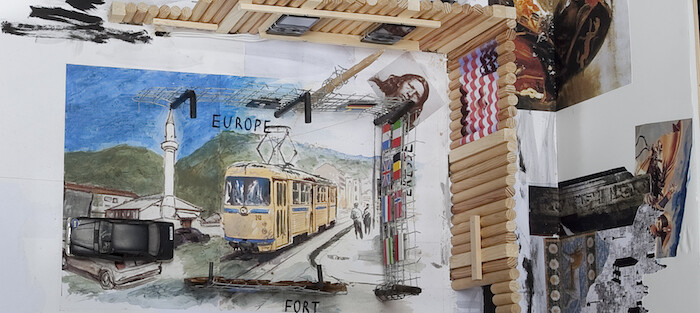In 2006, French filmmaker and polymath Jean-Luc Godard was commissioned to curate an exhibition at the Centre Pompidou, devising a series of 18 maquettes—nine large, nine small—as a plan for “Collage(s) de France: Archaeology of the Cinema.” The exhibition would link a series of rooms—each with its own title, like “Myth (allegory of cinema),” “The Camera (metaphor),” and “The Real (reverie)”—featuring objects, artworks, and videos. The result would be a kind of funhouse excursion through the director’s major themes and obsessions: cinematic and media images, the patrimonies of Europe, Hollywood, and their cultural and ideological peripheries.
But the exhibition was not to be: after two years of work, Godard abruptly abandoned the project, leaving the museum’s then-director of cultural development, Dominique Païni, to construct an attenuated version in its place: “Travel(s) in Utopia, Jean-Luc Godard 1946–2006, In Search of a Lost Theorem,” in which paintings by Nicolas de Staël and Henri Matisse were exhibited in proximity to excerpts from films by Godard and his idols (like Fritz Lang and Robert Bresson) and collaborators (like his longtime partner Anne-Marie Miéville).
While Godard’s original idea for the show was never realized, his maquettes (all from 2004–2006)—eventually deposited in one of the rooms of the exhibition—remain, and these form the basis of “Memories of Utopia.” Intricately, if shabbily, constructed from a bewildering set of materials—foamcore, watercolor, felt pen, wood, glue, plexiglass, motorized mechanisms, lamps, iPods, books, and all kinds of stray junk—these maquettes are perhaps in themselves more satisfying than the exhibition they envisage, offering a playfully diminutive, dollhouse-like treatment of a rather bombastic set of ideas. In this form, Godard’s show at Miguel Abreu, spread across the gallery’s two locations and supplemented with videos, sketches, and reading materials, takes on the pedagogical character hinted at in its punning title (which alludes to the Collège de France), constructing a space of “free research.”
The Pompidou’s press release for “Travel(s)” applies just as well to Godard’s original designs: “a poetic and philosophical meditation based on a link-up method—a montage of images borrowed from the history of art and the cinema, current events and [Godard’s] films.” Godard’s relation to traditions of collage and montage has dominated the reception of his work since the beginning of his career in the late 1950s. In 1965, no less a figure than Louis Aragon placed him squarely in the same lineage as Georges Braque and Pablo Picasso (and, by extension, yoking cinema with a tradition of painting). It was on the same grounds that he drew the derision of the French avant-garde, notably the Situationists, who saw in Godard’s work a crass banalization of their own more polemical methods. What could be more damning, after all, than the famous “alternate title” of Godard’s 1966 film Masculin Féminin—“The Children of Marx and Coca-Cola”—which reduces collage’s radical juxtapositions to the stultifying onslaught of commercial image-making?
Indeed, from his brief late-1960s “Maoist” period onward, Godard seems to have taken this critique to heart, transforming his mode of collage into a more autocritical and instructive procedure—what critic Serge Daney called “Godardian Pedagogy,” the cinema as classroom.1 Jacques Rancière has noted a similar trajectory: from his early work’s “clash of contraries… between the world of ‘high culture’ and the world of the commodity,” to the more fusion-like approach of his later work. This “fusion of images,” Rancière writes, “attests to… the reality of an autonomous world of images and its community-building power… the unforeseeable encounter of cinematic shots with the paintings of the imaginary Museum, of the images of death camps and literary texts taken against their explicit meaning.”2
In this sense, the aborted exhibition—Godard’s encounter of cinema, painting, atrocity, and literature within an “imaginary museum”—takes up an instructive position alongside his cinematic work. A model for a room entitled Murder (sesame) (theorem) (editing) intersects paintings by Diego Velazquez and Jacques-Louis David, a Gustave Doré engraving, a photograph of the 1956 Hungarian Uprising, images of Eisenstein and Lauren Bacall, enlarged citations from Jean Racine, Emmanuel Levinas, and the Bible, and a copy of Raymond Chandler’s The Long Goodbye (1953). The rough assemblage envisioned here offers precisely the place of playful association and irreverent referentiality that Godard approaches in his films. And yet—crucially—we encounter this spatial montage not in the spectacular environs of either the cinema or the Pompidou, but hovering above it: peering into an imaginary museum, a mock-up never to be executed. It was perhaps Godard’s insight that, rather than subsume the viewer in the spectacle of either an exhibition or a film, these collages and collisions and fusions would be better inspected from above—that is, from his own point of view. The museum is not a classroom.
—For the time being only three official images from the exhibition have been released. Additional views will be available in a later date. art agenda will inform readers when they become available.
Serge Daney, “Le thérrorisé (pédagogie godardienne),” Cahiers du Cinéma 262-3 (January 1976): 32-40.
Jacques Rancière, Aesthetics and Its Discontents, trans. Steven Corcoran (Cambridge: Polity Press, 2009), 122.


